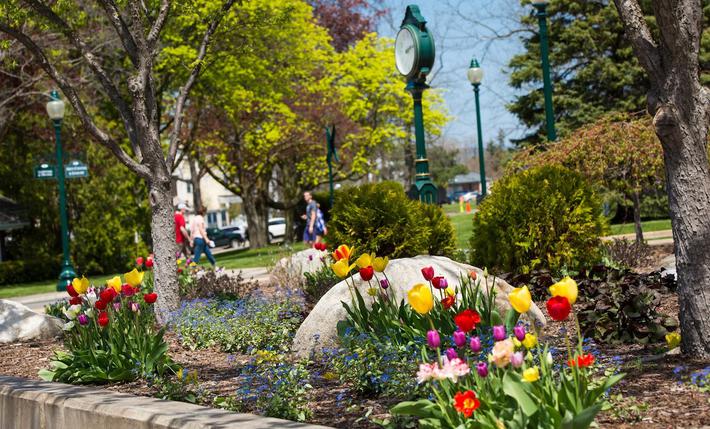
Winter driving: Speed, caution and snow tires
By Ross Boissoneau | Jan. 14, 2017
It may be the most wonderful time of the year, but ice and snow make it the slipperiest, whiteouts the hardest to see in, and temperatures certainly make it the coldest. Winter is not for the faint of heart, and for drivers it presents numerous challenges.
How do you make the best of it then? We talked with several experts about how to approach winter driving. One thing they all agreed on was the Boy Scout motto: Be prepared.
First things first, according to Dave Surowitz, general manager at Marathon Automotive in Traverse City. That means prepping for winter long before snow flies. “The timing of prevention (means doing it) before we get to winter. Check the cars before winter gets here. Inspect it in early fall,” he said, mentioning things like the battery, spare tire, coolant level and spark plugs. “It reduces the stress level.”
That’s true for both those driving and those who love them. Surowitz points to college students, who probably aren’t thinking about getting their car winterized in August when they leave for school. Checking a car for any possible problem before winter hits can save time, money and lives.
He also swears by snow tires. “It’s always safest and best to put a set of winter tires on,” he said. “There’s a winter-rated all-season tire, but nothing beats snow tires.” He estimated only a third to half of the customers at Marathon invest in snow tires. He does understand they are an expense not everyone can afford. For those who can’t afford a second set of tires, he suggested getting the best tires they can afford, regardless of the season. “Good tires are a must.”
John McLeod is a police officer with Boyne City, as well as the owner of Classic Instruments, which provides instrumentation for classic autos of all sorts. He agreed that the first, best and most important step is making sure your tires are the best they can be. “First, get snow tires. That makes a good two-wheel drive (vehicle) drive like four-wheel. If not snows, make sure the tires are in good shape and have the proper air pressure.”
McLeod also extolled the virtues of having a safety kit in your car. “A blanket, flares — that kit you got from dad,” he said with a laugh. “Especially extra clothing or a blanket. You’ve hit a deer, the car can’t run, and it’s freezing.”
He also advised against getting out of the car to try to fix something, particularly on a busy road. “There’s not always enough room. Don’t go outside and work on it. Safety is the No. 1 issue. Call 911, call the police, call a wrecker. You’re not bothering the police,” he said, noting they’d much rather go on what might turn out to be an unnecessary call than have to deal with injuries.
Those sentiments are echoed by state police Trooper Ron Rabineau. The 27-year veteran, who has spent his career in Gaylord, said that with slippery surfaces and reduced visibility, it’s more important than ever to pay attention to the road rather than whatever is going on inside the vehicle. “Pay attention to driving. Focus,” he said. There are so many distractions today, starting with just the basic equipment. “There are lots of distractions with standard equipment: climate control, speed, radio.”
Add in the challenges presented by passengers or cell phones, and you have even more potential for disaster. “I’m a parent of three teen drivers. I speak from experience,” he said.
When it’s snowing and/or blowing, he said visibility is of paramount importance. “Keep your headlights on, and keep your windows and windshield free of snow.” And if you suddenly find yourself in a whiteout, don’t stop. “Try to keep moving slowly. The guy behind you doesn’t expect you to be stopped. Turn on your flashers.” In other words, see and be seen.
Brian Gutowski, engineer/manager at the Emmet County Road Commission, said snow and wind means visibility can get pretty bad. That’s a problem all around. “If you see a snowplow, back off. When a plow hits a drift, snow will cover everything and cause a whiteout. When you can’t see us, we can’t see you. Leave plenty of space,” he said.
When snow is accumulating and drifting in the roadways, the local road commission is your best friend. But even those huge snowplows may have a hard time keeping up when blizzard conditions hit. “When there’s lots of snow, roads will drift shut. It’s hard to keep up.”
Making things worse is that when it does get windy, the road commissions use less salt and sand. That may seem counterintuitive, but the blowing can do two things, both of which are detrimental. It can scatter the salt and sand, making it ineffective. Worse, he said the salt can cause and attract moisture, which when cold will simply refreeze, making it worse.
One last bit of advice comes from all of them, in different words. “Keep your speeds down,” said Rabineau.
“If you’re in a hurry, don’t go,” said McLeod.
And from Surowitz: “Nothing replaces caution.”
Ross Boissoneau is a freelance writer.
Trending

Lakeside Weekend Adventures
The little lakeside corner of the world made up of Bay Harbor, Petoskey, Walloon Lake, and Harbor Springs is always full o... Read More >>
What to Do This Memorial Day Weekend, from Parades to BBQs to Concerts
Memorial Day Weekend, a time to honor and remember those who have served and fallen in the United States Armed Forces, has... Read More >>
A Birder's Paradise
The Beaver Island Birding Trail celebrates its annual Birding Foray May 24-26. The weekend consists of multiple field trip... Read More >>


